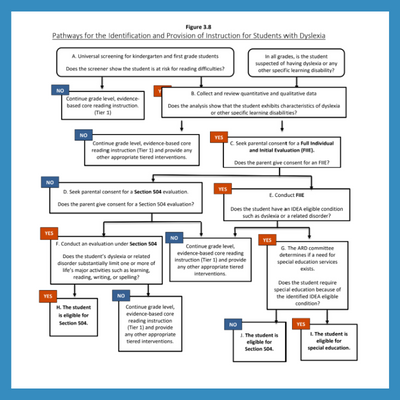- Prosper ISD
- About Prosper ISD Dyslexia Services
- Prosper ISD Dyslexia Services
Definitions and Characteristics of Dyslexia
-
Texas Education Code (TEC) §38.003 defines dyslexia and related disorders in the following way:
“Dyslexia” means a disorder of constitutional origin manifested by a difficulty in learning to read, write, or spell, despite conventional instruction, adequate intelligence, and sociocultural opportunity.
“Related disorders” include disorders similar to or related to dyslexia, such as developmental auditory imperception, dysphasia, specific developmental dyslexia, developmental dysgraphia, and developmental spelling disability.
TEC §38.003(d)(1)-(2) (1995) http://www.statutes.legis.state.tx.us/Docs/ED/htm/ED.38.htm#38.003
The International Dyslexia Association defines “dyslexia” in the following way:
Dyslexia is a specific learning disability that is neurobiological in origin. It is characterized by difficulties with accurate and/or fluent word recognition and by poor spelling and decoding abilities. These difficulties typically result from a deficit in the phonological component of language that is often unexpected in relation to other cognitive abilities and the provision of effective classroom instruction. Secondary consequences may include problems in reading comprehension and reduced reading experience that can impede growth of vocabulary and background knowledge.
Adopted by the International Dyslexia Association Board of Directors,
November 12, 2002
Students identified as having dyslexia typically experience primary difficulties in phonological awareness, including phonemic awareness and manipulation, single-word reading, reading fluency, and spelling. Consequences may include difficulties in reading comprehension and/or written expression. These difficulties in phonological awareness are unexpected for the student’s age and educational level and are not primarily the result of language difference factors. Additionally, there is often a family history of similar difficulties.
The following are the primary reading/spelling characteristics of dyslexia:
• Difficulty reading words in isolation
• Difficulty accurately decoding unfamiliar words
• Difficulty with oral reading (slow, inaccurate, or labored without prosody)
• Difficulty spelling
It is important to note that individuals demonstrate differences in degree of impairment and may not exhibit all the characteristics listed above.
The reading/spelling characteristics are most often associated with the following:
• Segmenting, blending, and manipulating sounds in words (phonemic awareness)
• Learning the names of letters and their associated sounds
• Holding information about sounds and words in memory (phonological memory)
• Rapidly recalling the names of familiar objects, colors, or letters of the alphabet (rapid naming)
Consequences of dyslexia may include the following:
• Variable difficulty with aspects of reading comprehension
• Variable difficulty with aspects of written language
• Limited vocabulary growth due to reduced reading experiences
-The Dyslexia Handbook, 2021 Update:
Procedures Concerning Dyslexia and Related Disorders
Screening
-
In 2017, the 85th Texas Legislature passed House Bill (HB) 1886, amending TEC §38.003, Screening and Treatment for Dyslexia, to require that all kindergarten and first grade public school students be screened for dyslexia and related disorders. Additionally, the law requires that all students beyond first grade be screened or tested as appropriate.
-
Texas Education Code §38.003 mandates that kindergarten students be screened at the end of the school year. The grade 1 screening must conclude no later than January 31 of each year.
-The Dyslexia Handbook, 2021 Update:
Procedures Concerning Dyslexia and Related Disorders
-
Evaluation and Identification
-
 The evaluation and identification process for dyslexia can be multifaceted. The process involves both state and federal requirements that must be followed. The evaluation and identification process for students suspected of having dyslexia is guided by the Individuals with Disabilities Education Act (IDEA).
The evaluation and identification process for dyslexia can be multifaceted. The process involves both state and federal requirements that must be followed. The evaluation and identification process for students suspected of having dyslexia is guided by the Individuals with Disabilities Education Act (IDEA).-The Dyslexia Handbook, 2021 Update:
Procedures Concerning Dyslexia and Related Disorders
See Dyslexia Handbook (2021) Update Summary
-The Dyslexia Handbook, 2021 Update:
Procedures Concerning Dyslexia and Related Disorders
Dyslexia Instruction
-
For the student who has not benefited from the research-based core reading instruction, the components of instruction will include additional focused intervention as appropriate for the reading needs of the student with dyslexia. Standard protocol dyslexia instruction provides evidence-based, multisensory structured literacy instruction for students with dyslexia. A standard protocol dyslexia instructional program must be explicit, systematic, and intentional in its approach. This instruction is designed for all students with dyslexia and will often take place in a small group setting.
Standard protocol dyslexia instruction must be—
• evidence-based and effective for students with dyslexia;
• taught by an appropriately trained instructor; and
• implemented with fidelity.
Instructional decisions for a student with dyslexia must be made by a committee (Section 504 or ARD) that is knowledgeable about the instructional components and approaches for students with dyslexia. It is important to remember that while dyslexia instruction is most successful when provided as early as possible, older children with reading disabilities will also benefit from focused and intensive remedial instruction.
For students with dyslexia who have been determined eligible for and who are receiving special education services, specially designed instruction must also address the critical, evidence-based components.
-The Dyslexia Handbook, 2021 Update:
Procedures Concerning Dyslexia and Related Disorders
Prosper ISD uses research-based curriculum such as Take Flight (Texas Scottish Rite Hospital) and the Orton-Gillingham Approach to provide evidence-based, multisensory structured literacy instruction for students with dyslexia.
Reach out to your child’s teacher and campus dyslexia therapist with further questions.

